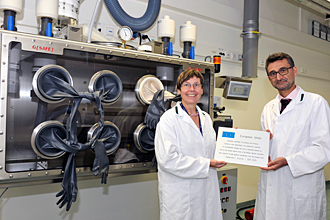First of 20 Glove Boxes Installed at IAEA Nuclear Material Laboratory (NML)

Gabriele Voigt, Director of the IAEA Office of Safeguards Analytical Services, and Vladimir Sucha, European Commission Director General for the Joint Research Centre with the first newly installed laboratory glove box at the IAEA Nuclear Material Laboratory.
The Nuclear Material Laboratory (NML) at the IAEA (International Atomic Energy Agency) Office of Safeguards Analytical Services has taken a major step towards full operation, with the installation of the first of twenty glove boxes. The glove boxes will enable heavy elements in inspection samples to be handled safely.
The laboratory’s core function, in line with the mission of the IAEA, will be to provide credible assurance that nuclear material is not being diverted from peaceful purposes.
Laboratory Modernisation Programme
This is a milestone in the state-of-the-art laboratory’s phased entry into full service at the end of 2014, and is part of a modernisation programme in progress throughout the centre in Seibersdorf, Lower Austria.
The new, state-of-the-art Nuclear Material Laboratory will replace a lab that has been in service since the 1970s, analysing samples from IAEA nuclear facility inspections worldwide. The lab processes and measures samples of uranium, plutonium, diluted spent fuel dissolver solution and high activity liquid waste materials from all stages of the nuclear fuel cycle. Analytical chemistry, radiometric techniques and mass spectrometry, including thermal ionisation mass spectrometry (TIMS), are used to condition and determine the elemental and isotopic composition of radionuclides in the samples.
Glove Boxes for Safety
Due to the highly sensitive nature of samples from nuclear facility inspections, each analysis will be restricted to a dedicated, controlled area, specially equipped to ensure safety, quality control, avoid cross-contamination and to conform to strict security requirements.
Air-tight glove boxes are essential for a controlled environment when handling harmful materials. The air pressure inside the box is lower than the pressure in the laboratory. For safety, air throughout the NML building will be constantly filtered and monitored for radiation. This is vital when conducting this type of analysis, eg measuring the concentration and isotopic composition of actinides.
Scientific Partnership
The construction of the NML has been made possible by generous donors including the European Union, who have provided financial support and technical advice. This includes sponsorship of several specialised areas, including the thermal ionisation mass spectrometry (TIMS) and chemistry laboratories, as well as the sample logistics area. The EU will continue to provide technical support, based on the long-standing cooperation between the IAEA and the European Commission’s Joint Research Centre.
Vladimir Sucha, European Commission Director General of the Joint Research Centre, joined the Director and staff of the IAEA Office of Safeguards Analytical Services to mark the installation of the first glove box.
“The IAEA laboratories have to be world class. The international community relies on the conclusions of the IAEA Department of Safeguards concerning the non-diversion of nuclear material, and we have to give the IAEA the tools it needs to do the job,” said Commission Director General Sucha. “That’s why the European Union is so pleased to be a major contributor to this renovation effort and will continue to provide technical support for the NML to maintain the high quality of analytical performance.”
The success of the laboratory’s construction greatly benefited from close scientific partnership with institutes of the European Union and individual member states, who contributed to the design of the building and formulation of its practices. This technical input and support has laid the foundation for greater cooperation in the implementation of nuclear safeguards in future.

